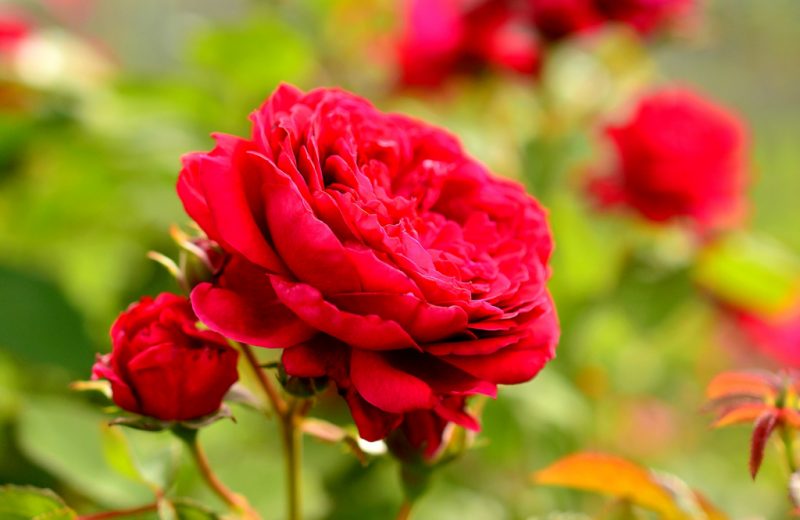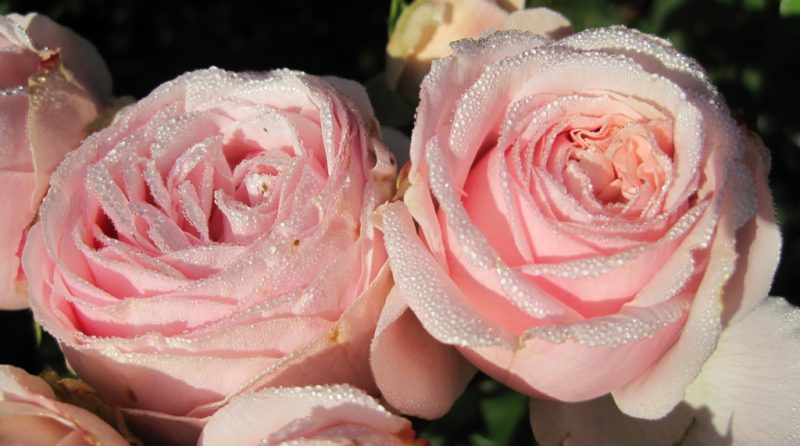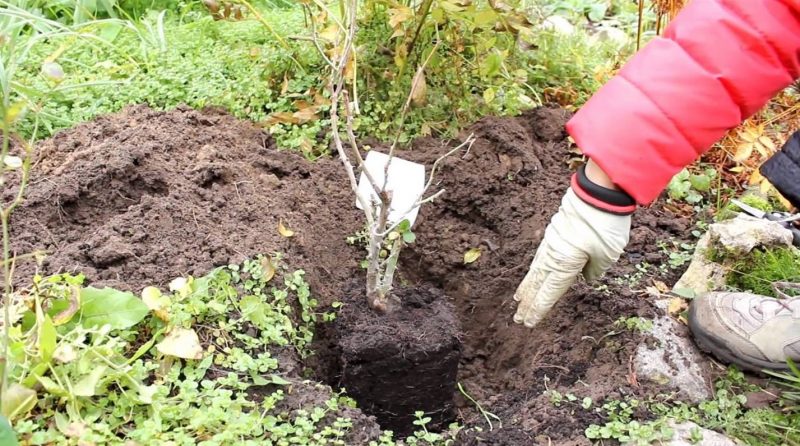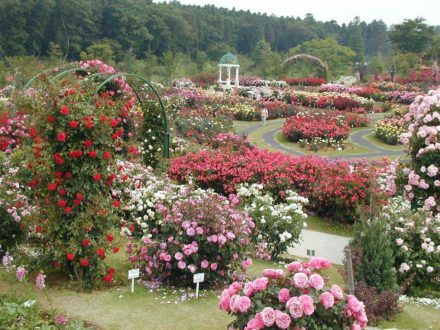From May to mid-July, the park rose is one of the main decorations of the garden. How such flowers were bred, which varieties are most popular, and how to care for them? Interesting information is in our article.
Material Content:
Park roses - what kind of variety, description
Park rose - what is it? This group of flowers was taken by breeders from simple rose hips, so these roses are undemanding in care and very hardy.
- Most of them bloom once a season, but flowering lasts for 1 to 2 months.
- Roses come in a variety of colors - from rich purple to snow white. There are one-color, but there are also variegated ones.
- The shape of the flowers is usually double, such roses have up to one and a half hundred petals.
- The height of the bushes is 100 - 200 cm.
In anticipation of the cold winter months, it is recommended to cover roses, however, some hybrids can be left without shelter.
- Those roses that bloom once a summer belong to an old group. They are not cut for the winter, otherwise the owners will not wait for flowering next year.
- Park roses, on which flowers bloom twice during the summer, are divided into frost-resistant and those that need protection from the cold in the form of a layer of covering material.
The best varieties for the Moscow region, the Urals, Siberia
In European countries, for example, in parks in France and England, you can see any varieties of roses, because winters are mild there.
To successfully plant roses in Russia, it is better to give preference to the most hardy varieties.
What varieties of park roses to choose:
- Golden Celebration. Hybrid. It captivates with a delicate golden color, blooms profusely.Such roses are characterized by an unusual smell that makes you think of a lemon. The variety tolerates even Siberian winters.
- Louise Odier. High bush, an abundance of buds. The shape of the flowers resemble a bowl, have a rich pink color and pronounced aroma.
- Chinatown. Roses are the color of dark honey, the aroma is strong, persistent. Lush bushes that grow well even on poor soils.
- Champlain. Scarlet rose lovers will appreciate this variety. There are many flowers on each bush. The variety not only tolerates frosts well, but is also famous for its resistance to disease.
- Morden Sunrise. This variety is easy to propagate with cuttings. The leaves are saturated green, smooth, finely varnished. Roses - yellow with a bright pink border of the petals.
All these varieties will be appreciated by both professionals and summer residents who do not have the opportunity to come to their site every day. These roses are unpretentious, and for some time they can do without leaving.
English and Canadian Park Roses
Many amateur gardeners prefer these flowers. English roses are sometimes referred to as “Austin” in memory of breeder David Austin. They are distinguished by sprawling bushes and large flowers, the diameter of which sometimes exceeds 10 cm. Roses are usually double or semi-double, have a very pleasant smell.
The following varieties of these roses are especially popular:
- Abraham Darby. Large flowers in the shape of a bowl have a copper color, the edges of the petals are edged with pink. This variety is distinguished by high shoots, flowers appear twice during the summer.
- Benjamin Britten. Breeders bred this variety at the beginning of the 21st century. Bushes usually do not reach a height of 1 m, the flowers are red-orange with a wine aroma. Blooms twice a season.
- William Shakespeare 2000. The bush is dense, grows rapidly. Terry red flowers. With regular feeding, a friendly and long flowering will be ensured. This variety rarely suffers from diseases.
Having engaged in the selection of park roses, Canadians preferred frost-resistant varieties. Therefore, all Canadian roses tolerate even very harsh winters.
It is better to grow them in the central and northern regions of Russia, in the south the flowers will not be too comfortable - you will often have to water them.
Canadian park roses are collected in inflorescences, powerful bushes, double flowers. The plant tolerates a decrease in temperature to - 40 - 45 ºС without any problems.
Popular varieties:
- John Franklin The height of the bush is up to 125 cm. The flowers are red terry, their edges are fringed. Delicate pleasant aroma. Single flowers can appear on the bush throughout the summer.
- John Davis The flowers are pink, in each brush there are more than a dozen. The bush is very spreading - in width can reach up to 2 m. Undemanding to care.
- Morden Sunrice. This variety has an unusual color. Roses have a rich orange color, which in the sunshine casts pink. Blooms several times during the summer, the bush reaches 1 m in height.
Varieties that do not require shelter for the winter
These varieties of roses are especially unpretentious:
- Polstjarnan. This variety will soon be 100 years old. Bushes are tall, up to 120 cm, white roses have a delicate aroma. Bloom throughout the summer.
- Emelie Refers to Canadian roses, does not need shelter for the winter. The flowers are large, pink. Elegant leaves - shiny, saturated color. The height of the bush may exceed 1 m.
- R. Eglanteria. Carries virtually any cold. The appearance resembles a dog rose. The aroma makes you think of green apples. Resistant to disease, can grow even in partial shade.
- Gartentraume. Terry flowers, have a pink tint, are famous for their delicate aroma. The variety is very suitable for growing as a green hedge. Frost-resistant and easy to clean.
Outdoor landing
The best time to update your rosary is September - early October. The seedlings will be perfectly rooted, and next spring it will be possible to enjoy the view of blossoming flowers.
Roses planted in the spring will also be accepted, but they will lag behind in development.
- The landing pit should reach half a meter in diameter and be approximately 45 cm in depth.
- Humus can be added to the soil, and a handful of wood ash will not hurt.
- If it was possible to acquire a rosette, the root system of which is closed, such a seedling carefully, trying to prevent shedding of the earth, is passed into a dug hole. If the roots are open, they are examined and damaged ones are removed.
- During the planting of flowers, the young plant is buried so that there is a layer of earth about 10 cm above the grafting site. Then the shoots will appear together, the rose will avoid many diseases.
- The planted plant is abundantly watered, it is desirable to cover the soil around with a layer of mulch.
- Separate bushes can be planted at a distance of 2 - 3 m from each other. If it is planned to create a hedge from the bushes, the distance between them should be approximately 80 cm.
Care and growing flowers
- Water the rose abundantly so that the water penetrates deeply. It is better to do this 2 to 3 times a week. The soil near the bushes should be moist. By the end of August, watering is minimized - the plant should prepare for winter.
- Bushes are fed from the next year after they have been planted. Most often, lovers use special fertilizers for roses, which are sold in stores, or the usual humus. But "overfeeding" garden beauties is not worth it! Make feeding no more than 2 times a month. The rose is responsive, and responds to such care with abundant flowering.
- Pruning roses for the winter should be very moderate. You need to get rid only of damaged branches, those that are already drying up, as well as from faded roses. In autumn, the branches bend low to the ground, fasten and cover for the winter. Successfully for this, flower growers use branches of coniferous trees, foliage or covering material purchased in a store.
- In spring, the plant is freed, old branches are cut, which are already more than 4 years old, the places of cuts are treated with var. Young branches are pruned for 1 to 2 buds to stimulate shoot growth.
Disease and Pest Prevention
The most dangerous and, at the same time, common diseases of park roses are powdery mildew, spotting, cytosporosis. Plants lose their beauty, in severe cases they face death.
In order to prevent the development of diseases, in early spring the bushes are sprayed with a solution based on iron sulfate. They also use drugs such as Topaz, Chistotsvet, Fundazol.
Among the most dangerous pests for these delicate plants are aphids, cartilages, spider mites, raspberry weevils. Most affected are the buds.
- After the bushes are freed from winter shelter, it is necessary to treat them with a urea solution.
- Such drugs as Iskra, Tanrek, Inta-Vir are successfully used.
- "Actovit", "Fitoverm", "Vermitek" will save the bushes from adult pests and their larvae.
- You need to regularly weed out weeds growing around roses. Often, pests hide in them.
Park roses in landscaping
Park roses are chosen by both experts and amateur gardeners to decorate the plots. They are planted as both group and single plants.
- A hedge of high powerful bushes will fulfill not only its intended purpose - to fence off a particular section of the garden, but will also serve as its decoration.
- Roses that encircle a garden arch look very beautiful. If you put several of these arches one after another, you get a real gallery - all in blooming roses.
- Often planted such a culture near the arbors, establish support for it near the benches.
- But they grow park roses and as a tapeworm in the flower beds. This allows you to focus on a large bush, strewn with flowers.
Park roses have already won the hearts of lovers, because they are as beautiful as they are unpretentious.






















